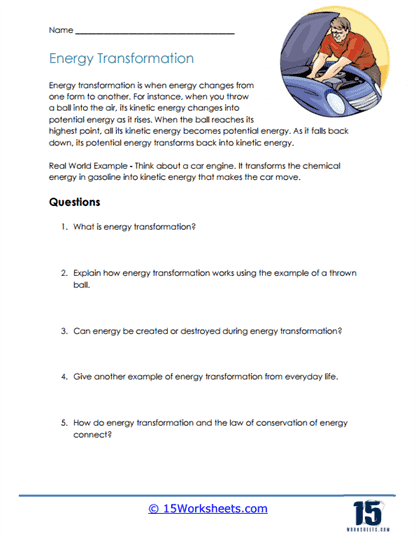Energy Transformations

Worksheet Description
This worksheet delves into the concept of energy transformation, a fundamental principle in physics that details how energy shifts from one form to another. It provides illustrative examples such as throwing a ball, where the ball’s potential energy, when at its peak height, transforms into kinetic energy as it descends. Additionally, the sheet offers a real-world example involving a car engine, demonstrating how chemical energy in gasoline can be transformed into kinetic energy that propels the car. A set of questions at the end aims to evaluate the student’s comprehension of the topic and their ability to apply the concept to everyday situations.
To master the concept of energy transformation, one must first understand the various forms of energy, such as kinetic and potential energy. By observing systems or objects in motion or at rest, students can identify moments where energy changes form. For instance, in the case of the thrown ball, one should note the point where the ball has the maximum potential energy and recognize the subsequent transformation into kinetic energy as it falls. Real-world observations, such as observing machinery or nature, can further solidify understanding as students witness energy transformation in action.
The worksheet aims to foster a clear understanding of the principle of energy transformation among students. By providing both theoretical explanations and tangible examples, it facilitates a comprehensive grasp of how energy changes form in various scenarios. The questions posed at the end encourage critical thinking and the application of this knowledge to everyday life. Ultimately, the worksheet strives to link the concept of energy transformation with the broader principle of the law of conservation of energy, emphasizing the interconnectedness of these foundational physics ideas.
